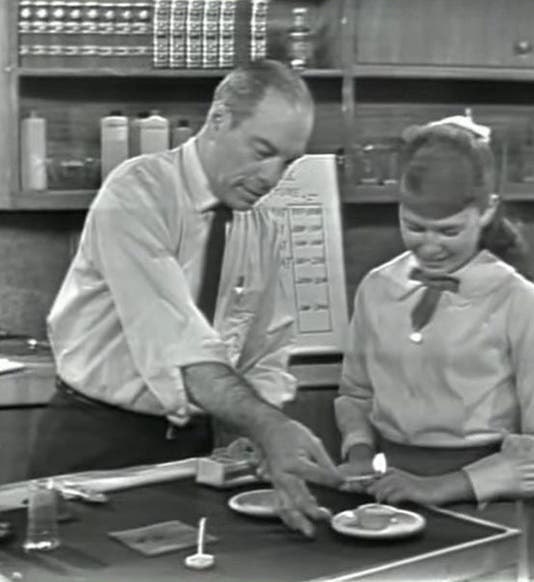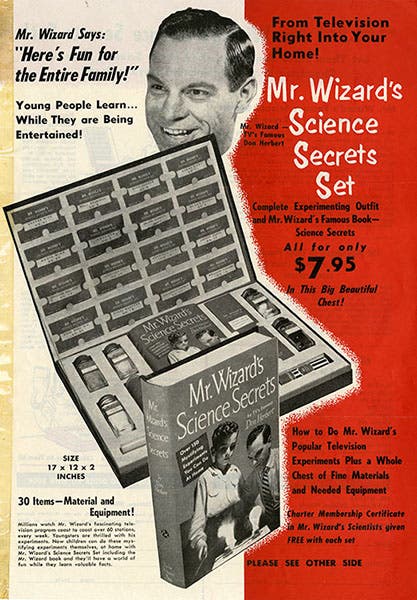Scientist of the Day - Donald Herbert – ��“Mr. Wizard”
Donald Jeffry Herbert – an American television personality better known as Mr. Wizard – died June 12, 2007, at age 89. Herbert's first 34 years of life gave no hint of his future career. Going then by his given name of Donald Kemske, he grew up and was educated in rural Wisconsin, majored in general science and English at what is now UW-La Crosse, and was considering an acting career, when the War broke out. He enlisted, took flight training, and ending up flying over 50 missions as a B-24 bomber pilot, surviving the war, and coming out as a decorated captain. Peacetime found him working for radio stations in Chicago as an actor for children's on-air theater. As television reared its cathode-ray-tube head in the late 1940s, Herbert (having dropped the Kemske from his name) got the idea of a science show for kids. He pitched the concept to station KNBQ in Chicago, they apparently liked the idea, and Meet Mr. Wizard went on the air on Mar. 3, 1951.
The format was simple: Herbert would be fiddling with something in his home, a neighborhood adolescent child, usually about 12-14, would drop by, and Herbert would do a demonstration with some simple apparatus – a pendulum, or a candle and thermometer, or a battery and a wire-wrapped nail. Mr. Wizard asked his assistant what he or she thought would happen if he put the candle under a glass or added weight to the pendulum, an opinion was offered, an experiment was done, often with results quite unexpected, and then the two tried to figure out what had happened and why. There were no scripts – just a few hidden note cards scattered around the set – and, at least in the first few years, it was all done live.
As it happened, Herbert was a natural for the role of the world's first "Science Guy." He was folksy and a bit avuncular – even in the early days – and the participating children were clearly at ease talking to him and responding to his experiments. He stumbled a bit now and then in his explanations – like ordinary people do in real life – but was never fazed, even on the rare occasions when experiments did not turn out as expected. He always wore a tie (never a bowtie), but his sleeves were usually rolled up to show he was just one of us. If you are new to Mr. Wizard, you are clearly not of my generation, and I suggest you take a break and watch one of his shows on YouTube – perhaps this one on the physics of a burning candle, which pays homage to a famous Christmas Day lecture by Michael Faraday in the 1850s. Here is the link. Our first image is a still from this episode.
Meet Mr. Wizard was a very successful children’s show. It was soon picked up by NBC, and it ran for 14 years, yielding over 540 episodes. When the show was cancelled (why ever, one wonders?), Herbert did popular science in other settings, such as on late-night talk shows, and the show was revived twice, once briefly in the 1970s, and then for a more extended period in the 1980s, with Herbert as an older Mr. Wizard.
I watched the original show quite a bit when I was young – it was on late Saturday morning, as I recall, and I just loved it. Nearly all his experiments were reproducible at home, and I did many of them. I think that one of my middle-school science fair offerings – a machine that cranked out oddly-shaped soap bubbles – had its genesis in a Mr. Wizard demonstration. I was too young to realize it at the time, but Mr. Wizard’s real genius lay in selecting suitable young actors for his collaborators and giving them an almost equal status in the flow of the program. The children were usually smart and engaging – such as young Rita in the show we linked to above – and their involvement meant that the show was seldom preachy – these were not TED talks for children, but rather conversations with a clever uncle. Herbert changed his young collaborators frequently – as he put it in an interview, once they got to be 14, they soon became know-it-alls and lost their innocent charm and appeal. Here are two more episodes, if you liked the first one: “Tricks with inertia,” from 1962, with young Phil as assistant, and “Photography,” from 1958, with Betty Sue dropping by to have her picture taken with a home-made camera. I haven’t drawn on the reincarnations of Meet Mr. Wizard in the 1970s and 1980s, since I never watched those later shows, although I understand they were very popular.
Science education on television began with Mr. Wizard, and everyone who came after him was in his debt. When Herbert died in 2007, the LA Times shrewdly asked Bill Nye to write a memorial notice. Here is the entire article. Nye was not shy about giving credit where it was due. “If any of you reading now have been surprised and happy to learn a few things about science watching “Bill Nye the Science Guy,” keep in mind, it all started with Don Herbert.” He concluded: “Thanks, Don; you changed the world.” Indeed, he did.
William B. Ashworth, Jr., Consultant for the History of Science, Linda Hall Library and Associate Professor emeritus, Department of History, University of Missouri-Kansas City. Comments or corrections are welcome; please direct to ashworthw@umkc.edu.







![Using an astrolabe to measure the depth of a well, woodcut in Elucidatio fabricae vsusq[ue] astrolabii, by Johannes Stöffler, 1513 (Linda Hall Library)](https://assets-us-01.kc-usercontent.com:443/9dd25524-761a-000d-d79f-86a5086d4774/a998eb50-55d2-4a88-ace2-a50aa5fa86e7/Stoffler%201.jpg?w=210&h=210&auto=format&fit=crop)

